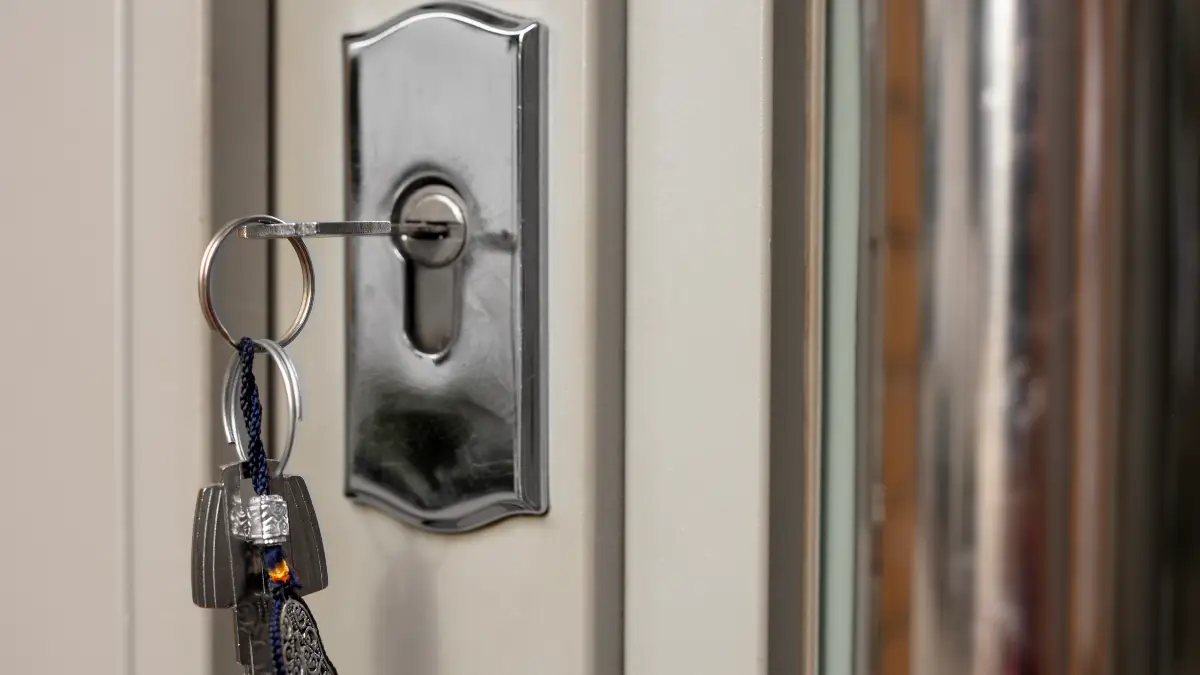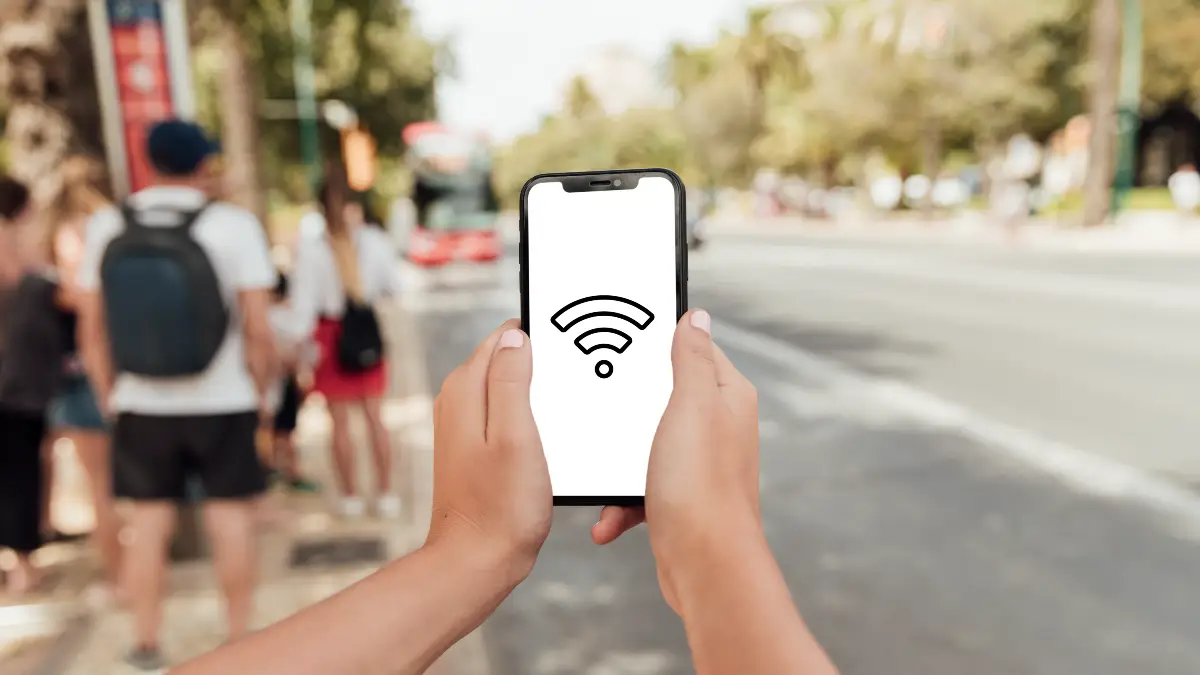Criminals size you up in just seven seconds. They’re not picking victims randomly—they’re hunting for specific signals that mark you as vulnerable and unprepared.
Research with convicted offenders reveals these aren’t just hunches. Criminals follow systematic patterns, looking for behaviors and environments that promise high reward with minimal risk.
The good news? You can flip the script. By recognizing and fixing these 12 red flags, you transform from “easy mark” to “not worth the trouble.”
This guide breaks down exactly what criminals watch for and the simple, proven steps that will remove you from their radar.
1. Distraction by Phones and Headphones in Public Spaces

The single most dangerous behavior that marks you as an easy target? Using your phone while walking.
The Department of Homeland Security explicitly warns: “Walking and looking down at your phone makes you an easy target for bad actors.” Research shows over 40% of pedestrians use their phones while moving through public spaces, creating a massive pool of vulnerable targets.
Why do criminals specifically seek out the phone-distracted? They’re getting multiple advantages.
- You can’t see them approaching
- Your reaction time drops significantly
- You can’t hear warning sounds or footsteps
- Your hands are occupied, limiting defensive options
- You broadcast inattention and vulnerability from a distance
“Not paying attention absolutely makes people more vulnerable.” In interviews with convicted offenders, phone distraction consistently ranks among the top three factors they assess when selecting robbery victims.
Headphones create similar problems by eliminating your auditory awareness. The “one earbud rule” offers a safer alternative—keep one ear uncovered and volume low enough to hear your surroundings.
The simple fix? Put your phone away completely in higher-risk situations. If you must use it, stop in a safe, populated location like a store rather than continuing to walk. This single change dramatically reduces your vulnerability and sends a clear signal to potential predators that you’re not an easy mark.
2. Vulnerable Walking Patterns and Poor Body Language

How you move through space tells criminals everything they need to know about your vulnerability. The landmark Grayson-Stein study showed videos of pedestrians to inmates convicted of violent crimes.
The results were striking—criminals unanimously agreed on victim selection based on nonverbal signals like walking pattern, posture, and awareness level.
The specific movement patterns that attract predators include:
- Abnormally short or shuffling strides (100% of shufflers were selected as targets)
- Limited arm swing
- Slumped shoulders and downward gaze
- Moving slower than surrounding foot traffic
- Jerky, uncoordinated movements
Research published in Criminal Justice and Behavior found that psychopathic offenders are 65% better than non-offenders at detecting vulnerability through body language. They automatically perceive nonverbal cues that signal exploitability.
The STAAR method developed by security expert Steve Kardian provides the solution:
- Stride: Take confident steps with medium length
- Tall: Keep shoulders back, chin up, spine straight
- Arms: Allow natural swing coordinated with leg movement
- Awareness: Scan environment regularly, make brief eye contact
- Relax: Project calm confidence rather than tension
Multiple law enforcement agencies emphasize this approach. “Walk with purpose and confidence.” This isn’t just psychological—it’s a proven deterrent that shifts criminal assessment from “easy target” to “not worth the risk.”
3. No Visible Home Security System

Homes without security systems are 300% more likely to be burglarized than protected ones. Yet only 32% of U.S. households have alarm systems installed, leaving the majority broadcasting vulnerability to potential intruders.
The University of North Carolina Charlotte study surveying over 400 convicted burglars revealed:
- 83% try to determine if an alarm is present before attempting burglary
- 60% would seek an alternative target if they detected a security system
- Among those who discovered alarms during burglaries, 50% would retreat immediately
The deterrent effect extends beyond functional systems to visible indicators. Security signs alone deter 25% of burglars, while visible security cameras deter 53%. One burglar admitted in prison interviews: “Alarms only make time spent inside less,” while most stated they consistently chose easier targets without visible security.
Modern security options include:
- Professional monitoring with video verification
- AI-powered Active Guard systems with real-time human intervention
- Wireless systems with cellular backup (can’t be defeated by cutting phone lines)
- Smart integration with mobile alerts and remote control
The cost-benefit analysis is compelling. The average burglary causes $2,800 in losses, while basic security systems start around $200 with $20-60 monthly monitoring.
Many insurance companies offer 15-20% discounts for monitored systems, offsetting much of the cost while dramatically reducing your risk of becoming a target.
4. Unlocked Doors and Windows

The simplest vulnerability creates the most opportunity for criminals. FBI data reveals that 37.8% of burglaries are “unlawful entries” requiring no forced entry—criminals simply walk through unlocked doors or climb through open windows.
ADT security research confirms that 34% of burglars enter through unlocked front doors, making this the single most common entry point.
The National Institute of Justice study found:
- 42% of burglars entered through unlocked windows
- 39% entered through unlocked doors
- Combined, these easy entry points account for most residential burglaries
When asked about entry methods, one inmate stated, “I would kick in the door rather than break glass. Loud bangs are better than loud glass breaking,” while another explained they checked doors first before attempting any forceful entry.
Most burglaries occur between 10 AM and 3 PM when residents are typically at work or school. Many homeowners leave doors unlocked during these “safe” daylight hours, creating prime opportunities.
Critical hardware every home needs:
- Deadbolt locks with 3-inch screws (not standard 0.5-inch screws)
- Solid core doors at least 1.75 inches thick
- Window locks and secondary locks for sliding doors
- Reinforced strike plates
The average break-in lasts only 8-10 minutes. Criminals seek to minimize time, noise, and evidence. Locked entry points force them to make noise breaking in, extending time required and increasing risk of detection.
5. Overgrown Landscaping and Hiding Spots Around the Home

Memphis Police Colonel Marcus Worthy demonstrated how overgrown bushes facilitate break-ins, showing how dense shrubbery allows criminals to check windows and attempt entry completely unseen from neighbors or street traffic.
Convicted burglars consistently identify landscaping as a selection factor. “I never did apartments. Too many neighbors…I preferred homes on dead end streets or cul-de-sacs” where natural surveillance is limited and vegetation provides additional concealment.
The principle underlying this vulnerability is Crime Prevention Through Environmental Design (CPTED), which emphasizes natural surveillance. Criminals avoid locations where they can be easily observed.
Overgrown bushes, trees near doors and windows, high privacy fences, and cluttered yards create blind spots that criminals exploit.
Effective landscaping for security involves:
- Trimming bushes below window level (3 feet maximum)
- Pruning tree branches at least 7 feet above ground
- Removing dense vegetation near entry points
- Maintaining yards—overgrown lawns signal absence or neglect
- Creating clear sightlines from street to house and between neighbors
The Rutgers University study on alarm effectiveness found that residential security measures decreased crime not just at protected homes but throughout neighborhoods.
Well-maintained properties with clear sightlines contribute to collective efficacy—the willingness of neighbors to intervene. Burglars noted in interviews that “nosy neighbors” ranked as their number one deterrent, even above security systems.
6. Weak or Reused Passwords Without Multi-Factor Authentication

Cybercrime losses in 2024 reached $16.6 billion according to the FBI Internet Crime Complaint Center—a 33% increase from 2023—with the average victim losing $19,372. Password-related vulnerabilities remain the primary entry point for most attacks.
Credential stuffing attacks exploit password reuse, using credentials stolen from one breach to access multiple accounts. When you use the same password across banking, email, social media, and shopping accounts, a single breach compromises everything.
The Cybersecurity and Infrastructure Security Agency (CISA) identifies strong passwords as one of four essential cybersecurity steps, alongside MFA, phishing awareness, and software updates. Despite this guidance, common password mistakes include:
- Using passwords under 12 characters
- Incorporating personal information like birthdays
- Relying on common patterns like “Password123”
- Reusing passwords across accounts
- Saving them in browsers or plain text files
Multi-Factor Authentication (MFA) provides the single most effective defense. CISA emphasizes that MFA makes you “significantly less likely” to get hacked because even if passwords are compromised, the second authentication factor blocks unauthorized access.
Password managers solve the reuse problem by generating and storing unique, complex passwords for every account. Leading 2025 options include:
- NordPass (best overall, XChaCha20 encryption, $2.49-$3.99/month)
- 1Password (excellent for families)
- Bitwarden (open-source with free tier)
- Keeper (feature-rich for business)
- Dashlane (comprehensive features)
These tools use 256-bit encryption, include dark web monitoring, and identify weak or reused credentials, creating protection that stops most credential-based attacks.
7. Social Media Oversharing Revealing Personal Information and Patterns

Digital footprints create physical vulnerabilities when you broadcast location data, vacation plans, personal details, and daily routines through social media.
This information serves multiple criminal purposes:
- Identity theft using personal details
- Physical security threats like burglary when posting real-time vacation photos
- Credential guessing using answers to security questions shared online
- Social engineering attacks building detailed target profiles
- Cyberstalking by tracking your routines and locations
The “Mosaic Effect” describes how seemingly harmless individual posts assemble into revealing profiles. Posting about your new home, child’s school, daily gym routine, pet’s name (often a password), and upcoming vacation separately seems innocent.
Collectively, criminals gain comprehensive intelligence: when you’re away, where you live, predictable schedules, possible passwords, and family information.
FBI Operation Level Up in 2024 identified 4,323 cryptocurrency fraud victims, with 76% unaware they were being scammed. Many scams began with social media-derived intelligence.
Criminals researched victims through public profiles before initiating contact, crafting personalized approaches that exploited visible interests and vulnerabilities.
Expert recommendations for protection:
- Review privacy settings regularly and make profiles private
- Turn off live location features across all apps
- Don’t post when out of town; share vacation photos after returning
- Avoid posting children’s information including schools and locations
- Remember that photo metadata contains GPS coordinates
- Consider what every post reveals about your patterns and vulnerabilities
8. Predictable Routines and Schedules

A motivated offender, a suitable target, and absence of capable guardians. Predictable routines create vulnerability by allowing criminals to plan around the absence of guardians.
Security consultant Luke Bencie explains that the criminal planning cycle includes a surveillance phase “which could last anywhere from a few minutes to a few weeks” where “the surveillance is complete once the victim’s pattern of life is established.”
The Oregon prison survey of 86 burglars found that 100% would knock on the door first to determine if anyone was home, using cover stories about looking for friends or offering yard work.
If answered, they’d ask for a fictional person, act surprised, and leave—while mentally noting the time and day. Return visits at the same time would confirm patterns.
Predictable patterns criminals monitor include:
- Leaving for work at the same time daily
- Returning home at consistent times
- Parking cars in the same spots
- Taking the same walking or driving routes
- Exercising or shopping on specific days
- Traveling on regular vacation schedules
Varying routines disrupts criminal planning. Law enforcement recommends:
- Alternate your routes and times of travel
- Stagger work departures by 10-15 minutes
- Vary shopping and exercise schedules
- Park in different locations
- Take different routes home
The key insight is that unpredictability itself provides protection. Rational choice theory shows that criminals seek to minimize risk and maximize success probability. Unpredictable targets increase planning difficulty and failure risk, causing many criminals to move to easier targets.
9. Lack of Situational Awareness and Ignoring Warning Signs

Every expert source identifies situational awareness as the foundation of personal safety—more critical than physical self-defense skills, security systems, or any other protective measure.
The UK National Protective Security Authority defines it as “being aware of what is happening around you and recognizing whether there could be a threat to your safety.”
Security research reveals that 90% of victims recalled noticing suspicious activity before crimes occurred but failed to act on their observations.
Most people possess the information needed to avoid victimization but don’t recognize warning signs or trust their instincts sufficiently to take protective action.
The OODA Loop provides a decision-making framework for active awareness:
- Observe: Continuously scan environment for threats
- Orient: Assess what you’re seeing within context
- Decide: Choose appropriate response based on assessment
- Act: Execute decision quickly and decisively
Cooper’s Color Code offers a complementary awareness system:
- Condition White (unaware): Never appropriate in public
- Condition Yellow (relaxed alertness): Should be your baseline
- Condition Orange (specific alert): When potential threats are identified
- Condition Red (immediate threat): Ready to act with threat imminent
- Condition Black (panic/frozen): Avoided through training
“Always be alert and aware of the people around you” and “Be aware of locations and situations which would make you vulnerable to crime, such as alleys and dark parking lots.”
This guidance reflects law enforcement’s understanding that awareness prevents most crimes by forcing criminals to abandon targets who notice their presence.
10. Displaying Valuables and Wealth Indicators

Criminals target visible wealth because it increases perceived reward while maintaining similar risk levels. Robbery research by criminologist Richard Wright found that robbers specifically look for people “flossing” (flaunting wealth), viewing it as justification for crime.
The UNC Charlotte study found that burglars prioritize homes based on observable value indicators.
Common wealth display mistakes include:
- Visible electronics through windows
- Expensive jewelry worn in public
- Luxury vehicles in high-crime areas
- Designer bags or expensive watches
- Counting cash in public
- ATM use at night in isolated locations
- Leaving valuable items visible in vehicles
- Broadcasting expensive purchases on social media
“NRA stickers = indication of guns to steal,” demonstrating how even intended security signals can backfire by advertising valuable targets.
The FBI reports that in robbery cases, criminals select victims based on “outward signs of wealth” as the primary criterion. Wright’s research with active robbers found they frequented areas where wealth displays were common: near ATMs, check-cashing businesses, and entertainment districts.
Strategic concealment reduces targeting risk:
- Keep valuables out of sight when in public
- Conceal electronics behind curtains or blinds
- Avoid jewelry and expensive accessories in high-risk areas
- Never count cash visibly
- Conduct financial transactions in secure, populated locations
- Remove expensive items from vehicles
- Never leave boxes from expensive purchases at the curb
Investment fraud reached $6.57 billion in 2024, with scammers researching targets extensively, often targeting individuals who post about financial success on social media.
11. Using Public WiFi Without Protection

Public WiFi presents severe security risks that many users underestimate. 40% of users reported their information was compromised on public WiFi, according to 2024 security research.
These networks lack encryption, allowing attackers to intercept unprotected data through man-in-the-middle attacks, packet sniffing, and session hijacking.
Criminals also create “evil twin” access points—rogue networks mimicking legitimate ones with names like “Free WiFi” or “Guest WiFi”—that route all traffic through attacker-controlled systems.
The attack progression is straightforward but devastating:
- Criminals scan for devices connecting to public networks
- They intercept unencrypted data traveling between devices and access points
- They capture login credentials for websites without HTTPS encryption
- They hijack active sessions to take over accounts
- They inject malware through compromised networks
Kaspersky research notes that 25% of cafe WiFi users experienced identity compromise, with financial credentials and personal information most frequently stolen.
Virtual Private Networks (VPNs) provide essential protection by encrypting all internet traffic before it leaves your device, making intercepted data unreadable. Even on compromised networks, VPN-protected connections remain secure.
Additional public WiFi safeguards include:
- Disabling automatic WiFi connection to prevent joining malicious networks
- Verifying network legitimacy with venue staff before connecting
- Only visiting HTTPS websites (padlock symbol in browser)
- Turning off file sharing on devices
- Using mobile hotspots instead of public WiFi when possible
CISA recommends that businesses prohibit employees from conducting company business over public networks without VPN protection, recognizing that WiFi vulnerabilities extend beyond personal risk to organizational exposure.
12. Ignoring Intuition and Failing to Trust Gut Feelings

The most profound safety vulnerability may be dismissing internal warning signals. Gavin de Becker, whose threat assessment systems are used by federal agencies, Supreme Court, and CIA, built his career on a foundational principle:
“You have the gift of a brilliant internal guardian that stands ready to warn you of hazards… Intuition is knowing without knowing why.”
De Becker identifies seven pre-incident indicators (PINS) that trigger intuitive warnings:
- Forced Teaming: Implying false connection (“We’re both stuck here…”)
- Charm and Niceness: Excessive politeness designed to disarm mistrust
- Too Many Details: Over-explaining to sound credible when lying
- Typecasting: Using mild insults to provoke engagement (“You’re too uptight to…”)
- Loan Sharking: Offering unsolicited help to create obligation
- Unsolicited Promise: Stating “I promise I won’t hurt you” (indicates harm was considered)
- Discounting the Word ‘No’: Refusing to accept rejection, testing boundaries
The barrier preventing people from acting on intuition is often social conditioning—particularly politeness programming that prioritizes not appearing rude over personal safety. “Give yourself permission to be ‘rude.’ Your survival trumps social niceties.”
Ohio State University research found that rape victims tend to be less able than average at interpreting nonverbal facial cues and detecting hostile intent, while rapists demonstrate superior ability to read expressions.
Trusting uncomfortable feelings about someone’s demeanor, even without conscious justification, activates protective action before situations escalate.
Nearly all victims remembered noticing suspicious activity before crimes occurred. The failure wasn’t information gathering—their subconscious correctly detected threats. The failure was response—they didn’t trust their observations enough to take protective action.


